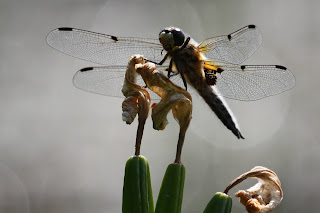Every so
often and often unexpectedly, special time is spent in a special place, and the
sun shines. Today was one of those
occasions. We had decided rather than
traveling to explore habitats near Kielder that our time would be spent closer
to home. What a wise choice this turned
out to be. I will not name the locality,
but local naturalists will I’m sure work it out for themselves.
Large Red Damselfly on Northern Marsh Orchid
As we
approached the lane leading to the rather unusual and almost hidden entrance a Common
Buzzard flew overhead and Speckled Wood Butterflies flew from
the hedge. We entered via the gate come
fence and found utopia, and were immediately surrounded by the song of Willow
Warblers. We had the area to
ourselves for the next few hours apart from a family calling by to count the
cygnets. I completely forgot that there
was a busy road nearby and I even cut out the sound of artillery fire which had
initially made me feel as though we were entering an ongoing conflict.
Mute Swan and cygnets
Little Grebe carrying young
The Mute
Swan pen stood sentinel like over her brood, and the hissing threat aimed
towards us made sure that we understood not to approach too closely. I don’t like the use of the term cute to be
used in respect of wildlife, but I suppose I could make an exception in this
case. The cob of the pair was
energetically washing and preening in the centre of the pond. I watched the brood climb from the water and
settle on the grass. They were not the
only family of birds here. A Little
Grebe carried her young across the water of the larger of the two reed bordered
ponds and a pair of Canada Geese guarded their one youngster. We kept our distance so that none of these
birds were in any way disturbed.
Four spotted Chaser Dragonfly
The odonata
caught the eye as soon as we approached the larger pond and initially it was
the large number of Four-spotted Chaser Dragonflies that caught the eye. After a while we saw the continually active Emperor
Dragonfly, male and female flying together at one point. I was unable to catch an image in flight, but
did eventually find a female ovipositing and managed a rather distant image,
which I do think shows the size of wings to good effect. As Sam said at the time, I’m pleased that
these dragonflies are not two feet long.
It is believed that prehistoric Dragonflies had wingspans of well
over two foot. Damselflies
were there in great number and included Azure, Common Blue, Blue-tailed
and Large Red Damselflies.
Four spotted Chaser Dragonfly
Azure Damselfly
Emperor Dragonfly ovipositing.
Having seen
the Speckled Wood Butterflies as we approached the area, other
butterflies recorded were Common Blue, Small Tortoiseshell, Peacock, Red
Admiral and Meadow Brown. A
Cinnamon Moth lifted as we approached.
We found a
Great Crested Newt, but sadly a dead one.
I tell you this newt isn't pissed, it is dead!
There was
much botanical interest, but it was the orchids that stole the show. I cannot ever remember seeing such an
abundance of Northern Marsh Orchids in such a small area. They far outnumbered the Common Spotted
Orchids and there were many fine specimens.
No doubt amongst them were some hybrids.
A naturalist at work
The stars of
the days extraordinarily strong cast were the Bee Orchids. I have certainly never seen Bee Orchids
in such number. Sam’s initial count of
spikes was 17, later updated to 28. I
pondered over these exotic, and so finely adapted orchids and how the flowers
have evolved to look like bees, and had similar thoughts as I had had when a
few days earlier had considered the plate structure of the Fulmar’s bill. By strange twist of fate, The Bee Orchid
is rarely pollinated by Bees, as it simply relies upon slight breezes to blow
the hanging pollinia onto the sticky stigma which leads to self-pollination. One can understand why so many plant hunters
who have travelled the world in search of rare orchids, have on occasion become
completely obsessed by them. Such
interesting and often beautiful plants, the orchids form probably the largest
flowering plant family.
Bee Orchid
I left
feeling, as I usually do, having been out in the field, that I am a half
glass full man. It is best to
remain positive as to what wonderful habitat, flora and fauna can still be
found close to home, this despite the attempts of those in power to allow building
on every patch of green land available. I
have restricted myself to mentioning the orchids only on this occasion despite
other interesting flora in the area.
Bee Orchid
A quick
visit to Arcot Pond provided the call of Lesser Whitethroat, but little
else. Having enjoyed visits to this area
in years gone by, I was rather disappointed on this occasion.
Black tailed Skimmer Dragonflies in tandem. Kibblesworth, as are following images.
Four spotted Chaser Dragonfly on Yellow Flag Iris.
Four spotted Chaser Dragonfly
A few days
later we spent a short time south of the river at Kibblesworth Ponds where
again we found grassland and pools providing a good array of plants, insects
and birdsong. I have added a few more
images by way of a bonus.
Scorpion Fly Pamorphidae
Common Blue Butterfly finding nutrient in the mud.
Five spot Burnet Moth
Small Heath Butterfly




















No comments:
Post a Comment